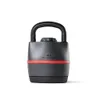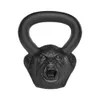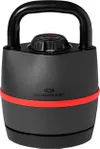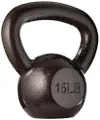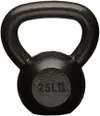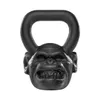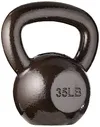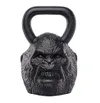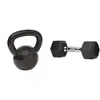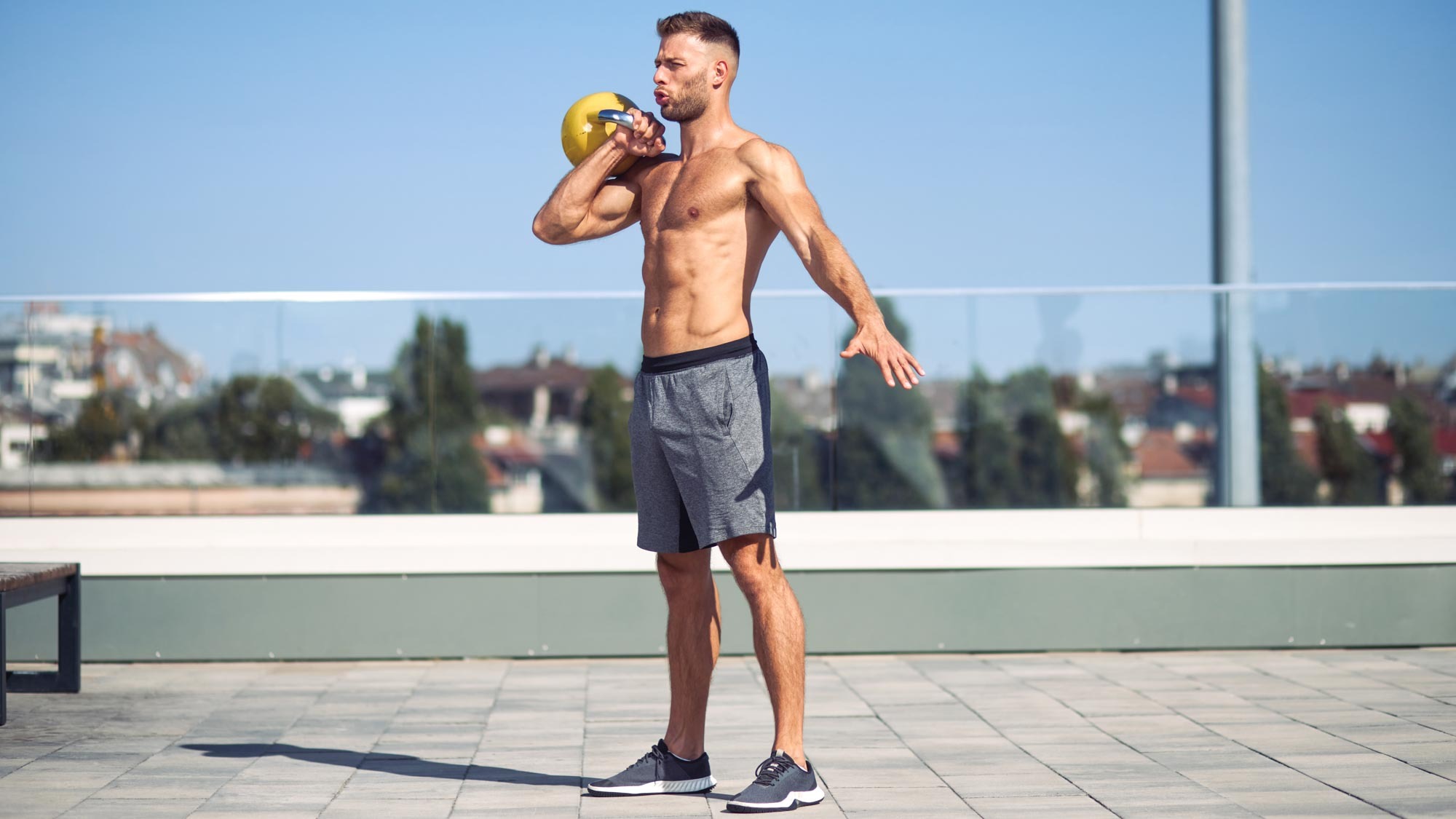
I’m increasingly enjoying seeing people use kettlebells instead of dumbbells, gym machines, or barbells in the gym. They give you plenty of freedom and range of motion during workouts and bring spice and explosive power to strength and conditioning exercises.
Whether using a set of the best kettlebells for kettlebell flow routines, cardio, or conditioning, bells are super fun to work with and give you plenty of opportunities to build strength and learn new movement patterns.
Below, I’ve put together a five-move upper-body kettlebell routine you can do from anywhere. Designed to target your back and biceps without pull-ups or any bar work in sight, you can still build and sculpt without them.
What is the 5-move kettlebell workout for building back and biceps muscles?
To help you get started, I've programed five moves that'll work your back and biceps with just a kettlebell. There are instructions for each exercise, and it's worth practicing the technique before adding them into your routine to get the most from your training and avoid injury.
1. Gorilla row
Like many rowing motions, gorilla rows hit the latissimus dorsi (lats), trapezius (traps), rhomboids, rear deltoids and biceps muscles. The unique leg position of the exercise also activates your lower body, as you hinge forward at the hips and lower your chest to parallel with the floor, you’ll also activate your core muscles, hip flexors, lower back and hamstrings.
How: 3 sets 8-12 reps per side
- Stand with your feet roughly shoulder-width apart
- Hold a kettlebell in each hand using a neutral grip (palms facing each other)
- Hinge forward at your hips and send your bum backward, keeping a gentle bend in the knees
- Start with the kettlebells close to the fronts of your legs and engage your core and glutes
- Row your right arm backward, driving your elbow toward your right hip
- Pause, then lower your arm and repeat on your left side
- Keep your chest parallel to the floor and back flat as you alternate sides.
2. Single-arm kettlebell clean
I love unilateral work; it gives you the opportunity to work on any muscular imbalances or weaker areas to help strengthen both sides of the body more equally. Unilateral exercises also rely on core engagement to stabilize the body when loading on one side.
Sign up to get the BEST of Tom's Guide direct to your inbox.
Get instant access to breaking news, the hottest reviews, great deals and helpful tips.
Kettlebell cleans hit a bunch of muscle groups and are technically more of a full-body exercise, not just posteriorly working the body. You’ll strengthen your back, chest, glutes, hips, hamstrings, triceps, biceps, delts and core muscles.
How: 3 sets 8-12 reps per side
- Start with a kettlebell between your feet and position your feet shoulder-width apart
- Grip the kettlebell overhand and hinge forward at the hips with a soft bend in your knees
- Engage your core
- Pull the bell upward into the front rack position, like you're zipping up a jacket
- Snap your hips forward, extend your legs and squeeze your glutes as the kettlebell travels upward
- The bell should stay close to the body and rotate onto the forearm and upper arm without banging on your wrist or flipping
- Keep your back straight, elbow close to your ribs and thumb next to your collarbone
- Pause, then reverse the motion back to the floor and switch sides
- To increase your range of motion, try lifting from the floor each rep from a dead stop position.
3. Alternating kettlebell row
Again, alternating rows tap into unilateral training, teaching the body better balance, coordination and stability while focusing on strengthening one side of the body at a time.
The neutral grip will help target the mid to upper back and rear deltoids, plus the biceps, forearms and lats through the pulling motion. You should feel plenty of engagement in the midback and shoulders during the row variation.
How: 3 sets 8-12 reps per side
- Stand holding your kettlebells and position your feet hip-width apart
- Hinge forward the hips and send your bum backward
- Keep a flat back and your core engaged. Your chest should be almost parallel to the floor
- Hold your kettlebells close in front of your body with palms facing each other using a neutral grip
- Row your right elbow toward your right hip, pause, then lower and repeat on the left side
- Continue alternating sides, keeping your hips square.
4. Kettlebell staggered-stance deadlifts
Deadlifts target the posterior chain, including the back, glutes and hamstrings, plus the hip flexors, core muscles, arms and shoulders. Like the clean, it’s more of a whole-body movement than people realize.
You can load more maximally with the barbell deadlift, however, using kettlebells allows you to work both sides of the body together without a stronger side taking over, which is why I love adding kettlebells to deadlifts when working with free weights.
In this instance, we hit the lower body, namely the hamstrings, glutes and hips, a little harder using a staggered stance.
How: 3 sets 8-12 reps per side
- Place a kettlebell on either side of your body
- Position your feet hip-width apart, then step your right foot back, roughly aligning your right toes with your left heel. Rest on the ball of your right foot
- Softly bend the knees, send your bum backward and hinge forward at your hips
- Maintain a flat back and neutral spine and brace your stomach, pulling your shoulders back and down
- Grip a kettlebell in each hand using a neutral grip (palms facing each other)
- Drive upward to stand, lifting the kettlebells
- With control, lower the weights toward the ground, pause, then drive upward again, extending the hips as you stand
- Switch sides.
5. Kettlebell pullovers
Pullovers can uniquely target the pectoralis major (pecs) while hitting the deltoids, lats, teres major, core and triceps muscles. Many trainers teach a flat back against the bench at all times.
I allow for a slight lift to account for individual anatomy, as long as the core is engaged, the upper and mid back are supported and you avoid overarching the spine due to a weight that is too heavy or limited upper body flexibility. Keep your wrists and forearms strong throughout and avoid flaring the elbows.
We use a dumbbell in the video above, but simply switch it out for a kettlebell. To increase upper body and shoulder engagement, press your hands into the bell, like you're trying to crush it between your hands.
How: 3 sets 8-12 reps per side
- Lay with your back against a workout bench and position your feet on the floor or the bench
- Ensure your head and hips are supported
- Hold a kettlebell by the bell or horns using both hands
- Extend your arms over your chest, elbows slightly bent and pointing upward rather than turned outward
- Brace your stomach and shoulders, then begin lowering the weight with control behind your head. Avoid allowing your lower back to excessively lift or arch
- Pause, then drive the weight forward to the starting position.
Benefits of this back and biceps kettlebell workout
Pull-ups are seen as the ultimate test in bodyweight strength training, but you don’t “need” to include them in your back and biceps workouts, although it’s a great goal to work toward.
When building muscle in your back and biceps, progressively overload your muscles by adding weight, increasing volume, or both, and include a mix of compound and isolation exercises to keep you mentally and physically stimulated in the gym.
I love that a set of kettlebells and just five exercises can help develop core strength and hit multiple major muscle groups. The routine is simple, efficient and effective without requiring a whole lot of equipment.
Moreover, kettlebell training can increase overall range of motion, balance, coordination and stability, which is why I prefer using free weights over gym machines during workouts. The added benefit of kettlebell training is that you’ll improve forearm strength and grip and can program toward strength, cardio, muscle growth, or power.
The back and biceps recruit together during pulling motions, in the same way that your chest and triceps do, so while isolation exercises (think biceps curls) are great to tack onto resistance workouts, you’ll still work your biceps using the exercises above.
Strengthening your back isn’t just about cutting v-shaped back muscles, but also targeting muscles responsible for posture, stabilization and protecting your spine, like your core, erector spinae (muscles that hug your spine) and rotator cuff (shoulder stabilizer muscles). Basically, it's about being functional, too.
More from Tom's Guide
- Forget heavy barbells — sculpt core and lower body muscle with this 5-move kettlebell workout
- Ditch sit-ups — you just need a resistance band and these 5 exercises to build a stronger core
- How much protein do you need to build muscle?

Sam Hopes is a level 3 qualified trainer, level 2 reiki practitioner and senior fitness writer at Tom's Guide. She is also currently undertaking her Yoga For Athletes training course. Sam has written for various fitness brands and websites over the years and has experience across brands at Future such as Live Science, Fit&Well, Coach, and T3.
Having worked with fitness studios like F45 and Virgin Active, Sam now primarily teaches outdoor bootcamps, bodyweight, calisthenics and kettlebells. She also coaches mobility and stretching-focused classes several times a week and believes that true strength comes from a holistic approach to training your body.
Sam has completed two mixed doubles Hyrox competitions in London and the Netherlands and finished her first doubles attempt in 1:11.
